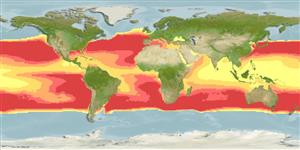Classification / Names
Common names from other countries
Main reference
Size / Weight / Age
Max length : 140 cm FL male/unsexed; (Ref. 3669); common length : 100.0 cm FL male/unsexed; (Ref. 9684); max. published weight: 60.3 kg (Ref. 40637); max. reported age: 9 years (Ref. 72462)
Length at first maturity
Lm 85.0, range 85 - ? cm
Environment
Marine; pelagic-oceanic; oceanodromous (Ref. 51243); depth range 0 - 600 m (Ref. 168)
Climate / Range
Subtropical; 10°C - 25°C (Ref. 168), preferred 27°C (Ref. 107945); 59°N - 46°S, 180°W - 180°E
Distribution
Cosmopolitan in tropical and temperate waters of all oceans including the Mediterranean Sea but not at the surface between 10°N and 10°S. Western Pacific: range extend in a broad band between 40°N and 40°S (Ref. 9684). Often confused with juvenile Thunnus obesus which also have very long pectorals but with rounded tips. Highly migratory species, Annex I of the 1982 Convention on the Law of the Sea (Ref. 26139).
Countries | FAO areas | Ecosystems | Occurrences | Introductions
Short description
Dorsal
spines
(total): 11 - 14;
Dorsal
soft rays
(total): 12-16;
Anal
spines: 0;
Anal
soft rays: 11 - 16. Anterior spines much higher than posterior spines giving the fin a strongly concave outline. Interpelvic process small and bifid. Body with very small scales. Pectoral fins remarkably long, about 30% of fork length or longer in 50 cm or longer fish. Ventral surface of liver striated and the central lobe is largest.
IUCN Red List Status (Ref. 115185)
Threat to humans
Harmless
Human uses
Fisheries: highly commercial; gamefish: yes
Tools
Special reports
Download XML
Internet sources
Estimates of some properties based on models
Phylogenetic diversity index
PD50 = 0.5039 many relatives (e.g. carps) 0.5 - 2.0 few relatives (e.g. lungfishes)
Trophic Level
4.3 ±0.2 se; Based on diet studies.
Resilience
Medium, minimum population doubling time 1.4 - 4.4 years (K=0.13-0.18; tm=4-6; tmax=10; Fec=2 million)
Vulnerability
High vulnerability (58 of 100)
Price category
